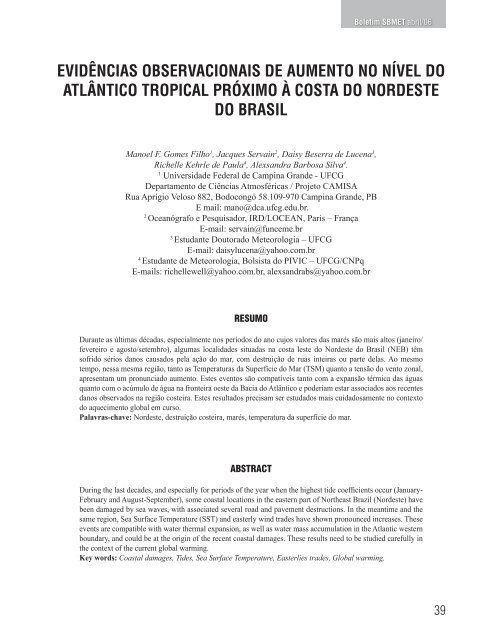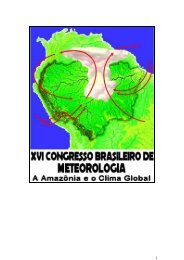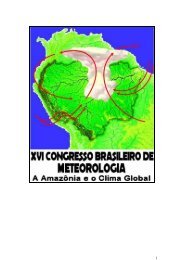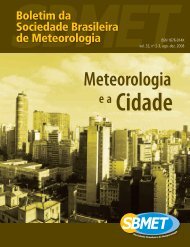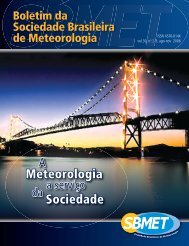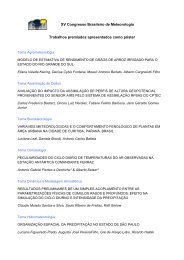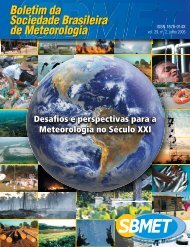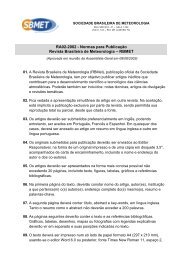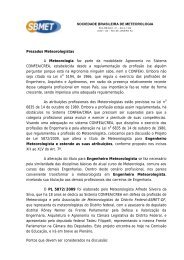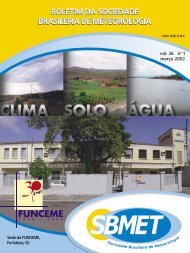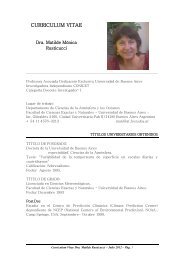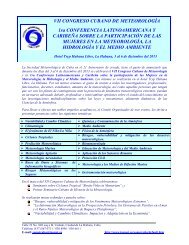Volume 30 No 1 - sbmet
Volume 30 No 1 - sbmet
Volume 30 No 1 - sbmet
You also want an ePaper? Increase the reach of your titles
YUMPU automatically turns print PDFs into web optimized ePapers that Google loves.
Boletim SBMET abril/06<br />
EVIDÊNCIAS OBSERVACIONAIS DE AUMENTO NO NÍVEL DO<br />
ATLÂNTICO TROPICAL PRÓXIMO À COSTA DO NORDESTE<br />
DO BRASIL<br />
Manoel F. Gomes Filho 1 , Jacques Servain 2 , Daisy Beserra de Lucena 3 ,<br />
Richelle Kehrle de Paula 4 , Alexsandra Barbosa Silva 4 .<br />
1<br />
Universidade Federal de Campina Grande - UFCG<br />
Departamento de Ciências Atmosféricas / Projeto CAMISA<br />
Rua Aprígio Veloso 882, Bodocongó 58.109-970 Campina Grande, PB<br />
E mail: mano@dca.ufcg.edu.br.<br />
2<br />
Oceanógrafo e Pesquisador, IRD/LOCEAN, Paris – França<br />
E-mail: servain@funceme.br<br />
3<br />
Estudante Doutorado Meteorologia – UFCG<br />
E-mail: daisylucena@yahoo.com.br<br />
4<br />
Estudante de Meteorologia, Bolsista do PIVIC – UFCG/CNPq<br />
E-mails: richellewell@yahoo.com.br, alexsandrabs@yahoo.com.br<br />
RESUMO<br />
Durante as últimas décadas, especialmente nos períodos do ano cujos valores das marés são mais altos (janeiro/<br />
fevereiro e agosto/setembro), algumas localidades situadas na costa leste do <strong>No</strong>rdeste do Brasil (NEB) têm<br />
sofrido sérios danos causados pela ação do mar, com destruição de ruas inteiras ou parte delas. Ao mesmo<br />
tempo, nessa mesma região, tanto as Temperaturas da Superfície do Mar (TSM) quanto a tensão do vento zonal,<br />
apresentam um pronunciado aumento. Estes eventos são compatíveis tanto com a expansão térmica das águas<br />
quanto com o acúmulo de água na fronteira oeste da Bacia do Atlântico e poderiam estar associados aos recentes<br />
danos observados na região costeira. Estes resultados precisam ser estudados mais cuidadosamente no contexto<br />
do aquecimento global em curso.<br />
Palavras-chave: <strong>No</strong>rdeste, destruição costeira, marés, temperatura da superfície do mar.<br />
ABSTRACT<br />
During the last decades, and especially for periods of the year when the highest tide coefficients occur (January-<br />
February and August-September), some coastal locations in the eastern part of <strong>No</strong>rtheast Brazil (<strong>No</strong>rdeste) have<br />
been damaged by sea waves, with associated several road and pavement destructions. In the meantime and the<br />
same region, Sea Surface Temperature (SST) and easterly wind trades have shown pronounced increases. These<br />
events are compatible with water thermal expansion, as well as water mass accumulation in the Atlantic western<br />
boundary, and could be at the origin of the recent coastal damages. These results need to be studied carefully in<br />
the context of the current global warming.<br />
Key words: Coastal damages, Tides, Sea Surface Temperature, Easterlies trades, Global warming.<br />
39


